Striped Jelly – Makes a One of a Kind Homemade Gift
This post may contain affiliate links. Read my full disclosure here.
I first saw striped jelly in a Facebook group and thought that it looked absolutely beautiful. There was only a photo, no instructions. The person who shared the photo said that her daughter had made some up for a local farm market. The daughter had planned to price it the same as the other jams, but the mom convinced her to charge extra because of the labor involved. Mom was right again, as the striped jelly sold out almost immediately, even at a much higher price.
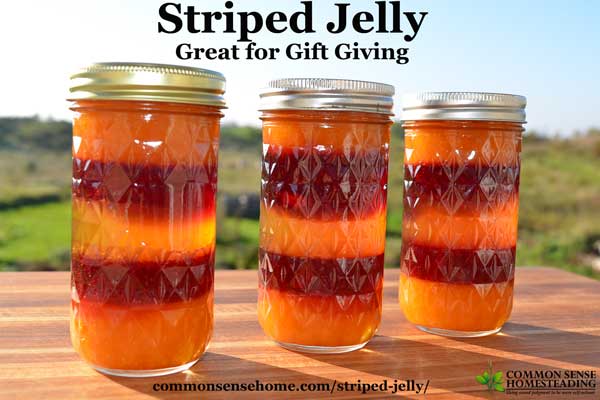
I was inspired to give striped jelly a try, so during the season, I saved and froze different types of fruit juice and puree. When my sister came to visit last weekend, she asked if I had any extra jams or jelly that her granddaughter could use for a school fundraiser. Since trying new ideas is always more fun when you have a “partner in crime”, I dug out my fruit stash and my sis and I made up 15 jars of beautiful fruit striped yumminess. Here’s how we did it.
By the way – if you don’t have a stash of fruit puree, remember that you can always use fruit juices or frozen fruit for jellies and jams.
Striped Jelly – Tips for Assembly
Use a tall, thin jar with straight sides to better display the stripes.
I chose 12 ounce quilted jelly jars. You could probably also use wide mouth pints or straight sided 8 ounce jars, but the added height of the 12 ounce gives more room for stripes without needing as much jelly to fill it as a pint jar.
Figure out how much jelly and jam you want to make for the number of jars you need to fill.
We made five single batches of jam and jelly, three low sugar and two full sugar. This divided evenly between 15 jars to make striped layers that were just over a quarter cup with less than a pint leftover that didn’t fit in a layer. We based layer thickness on the recipe that made the smallest amount of product, and having enough total product to fill all the jars started. The full sugar recipe made more jelly, so we kept a couple “spillover jars” to maintain even layer thickness.
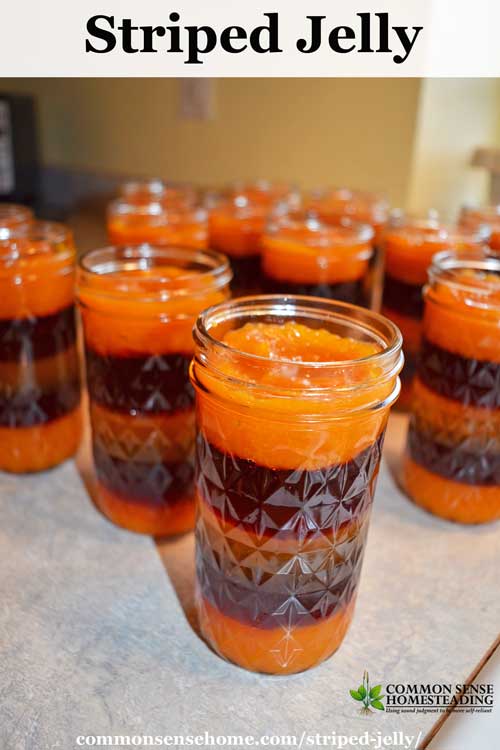
Make single batches of jam or jelly at a time.
There’s a sweet spot where the jelly or jam is warm enough to pour, but not so hot that it will melt and blend with the layer below it. You can to cook one layer at a time, two at max, or the jelly will get too cool to pour nicely. Jam tends to be firmer, so layers are less likely to bleed, but doesn’t let the light shine through. Jelly gives an appearance like colored glass, but is more likely to blend the layers.
Decide on complimentary jam and jelly flavor combinations.
In our case, we wanted fall colors, and I had certain purees stashed, so we worked with what was available. Our layers are (from bottom to top):
- Low sugar honey apricot jam
- Full sugar currant jelly
- Low sugar lemon ground cherry jelly
- Full sugar currant jelly
- Low sugar honey cinnamon apricot jam
We repeated flavors because I had more of that type of fruit, and because I felt the flavors worked well together. You could do all different flavors if you like, or as few as two different flavors.
Would you like to save this?
Other possible flavor combinations (or use your imagination):
- Blueberry, lemon and pear
- Strawberry, strawberry-rhubarb and apple
- Flower jellies – lilac, violet and dandelion
- Grape, pear and pineapple
Make sure your recipes have enough pectin.
I modified my full sugar lemon ground cherry jelly to make it low sugar for our striped jelly, and I should have used a bit more pectin. Our center yellow stripe didn’t set up quite as firm as I would have liked, so we ended up with the layers in some of our jars looking more like the contents of a lava lamp. Still tasty, just not tidy.
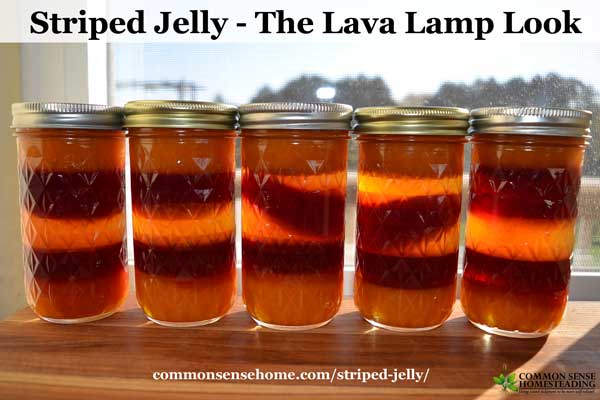
Pour the new layer of jelly onto a spoon held over the previous layer, or gently ladle in onto the top of the previous layer.
If you try to pour one layer directly on top of the previous layer, odds are that they will mix. You can diffuse the pour with a spoon, or simply add each layer by the spoonful – your choice. This is the tricky part, and requires some patience. You should allow each layer to cool and set a little, but not completely
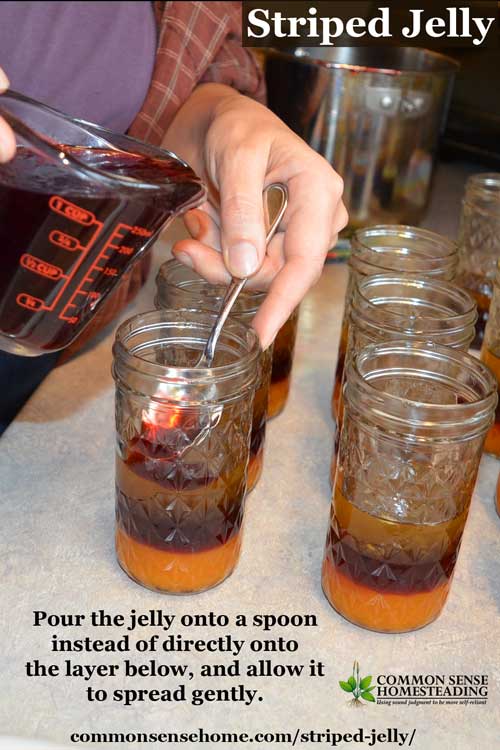
When jars are filled to 1/4 inch headspace, process for 10 minutes in a water bath canner.
Getting something to look funky is no reason to ditch safe canning practices. Unless you intend to eat all your striped jelly within a week or two, you should process the filled jars for ten minutes in a boiling water bath canner. Always keep your jars, implements and kitchen surfaces clean and sanitary.
What goes better with jelly than fresh baked homemade bread?
The clock is ticking on the my kickstarter project – funding a print edition of my new book, “Never Buy Bread Again – 20+ Homemade Bread Recipes”.
By pre-ordering your copies now, you can help me reach my funding goal and afford a print run in time for the holidays. The book is over 100 pages of full color recipes, troubleshooting tips, freezing and storage tips (before and after baking), recipes to make with leftover bread and much more. I’ve put over a year into creating this book, and I would truly appreciate your help in making it a reality.
Just click here to reserve your copy – no payment is required until the kickstarter wraps ups successfully on November 8th. (No payment at all if I fail, but I hope it won’t come to that.) Share and let your friends who like baking know, too.
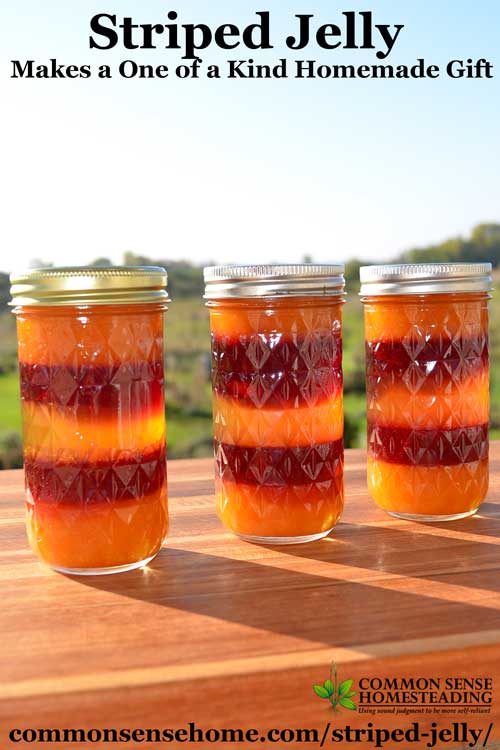





MMMMMm, This looks amazing, Thank you so much for sharing this with us. I would never have thought to do this myself, it is a wonderful noval idea. I am thinking Orange Jelly and Cranberry Jam together would be lovely. What do you think?? I am so inspired now and thinking of all kinds of flavors, like maybe Monkey Butter and Pineapple Jam.?? Any other ideas.??
How about lemon and blueberry? Apple and cranberry?
So its low sugar jam and full sugar jelly being alternated through the jar? Or is it all jelly with different sugar contents? I would like to do blackberry, and vanilla pear. Or orange and vanilla pear like a creamscicle.
We did a mix of full sugar and low sugar jellies since I was using what I had stashed, but you could do all low sugar or all full sugar.
The tricky parts are the slow pour (using the spoon to help spread evenly over the layer below) and using enough pectin in each layer that they set fairly firm so the layers are less likely to mix.
For instance, a jelly recipe that tends to be more like syrup wouldn’t work well.
I’m having a problem getting the jars to seal after the hot water bath. Wondering if having the jam cooler before going in is the problem. I’m going to try new lids and re-processing, but have you had this problem with your stiles jam?
I haven’t had that problem. Did you warm up the lids in warm water before putting them on the jars? I find that helps increase the odds of a good seal.
Definitely possible the lids weren’t warm enough — we were pretty fixated on getting the stripes right. Trying a re-processing tonight and hoping they don’t bleed more. At this point, they look fabulous, but I’d rather they not have to be refrigerated.
Thanks for the inspiration!
I know they say you don’t need to warm up the lids anymore with the new sealant, but I still do. I hope they work out for you.
That worked! This was a team effort, so juggling the two jams was easier. We did peach and blackberry and they look AMAZING. We used a waxed cloth piping bag to make the layers and keep everything nice and neat. Made the layering easy and fast.
Smart idea! So glad that the reprocessing worked.
I love this idea! Thank you for sharing. I won’t be using them up quickly and will need to process them…Will the layers keep even after processing in a water bath?
The firmer the jelly, the better the layers will hold, so if you use a very soft set jelly or jam, there will be more bleeding between layers. Both images in the post that have rings on the jars were taken after the jars were processed in a ten minute water bath. You can see the layers move a little, but stay mostly intact.
Wouldn’t the jellys or jam soften when they are put in the water bath??? Can you layer jelly on top of jam. Or do you keep them separated in different jars????thank you. Pat
We didn’t use jam, because we wanted a product that would let the light shine through so you could see the colors (jam would be opaque). If you didn’t mind layers that were chunky, you could use jam, but it would be tougher to get the layers even because of the chunks. Since jelly is smooth, it naturally sits fairly level. There was some bleeding between layers during processing, which you can see if you look closely at the photos. All jams and jellies process for the same time, so you can use the flavors that you prefer. We chose the flavors we did based on available fruit, flavors we thought would compliment each other, and bold color variation.
What a GREAT idea! Never would have thought of this myself, but, am always looking for creative canning projects. Brilliant!
It takes extra time, but for gift giving or to create a truly unique product for sale, I think it’s worth it.
I’ve never seen 12oz jelly jars!
How beautiful!
Thank you for sharing this incredible idea!
Glad you enjoyed them. I’ve used the 12 ounce jars to display other fruits, but these are the prettiest things I’ve made so far.